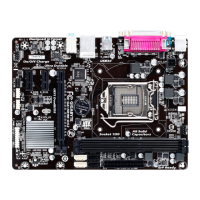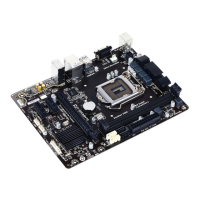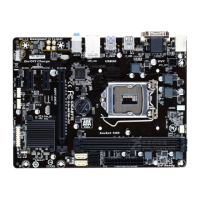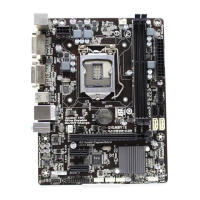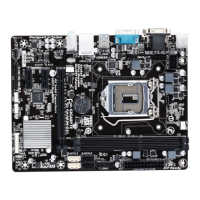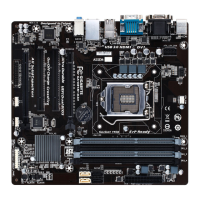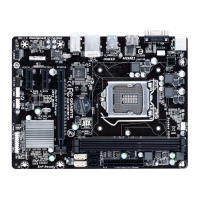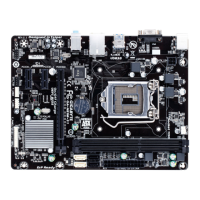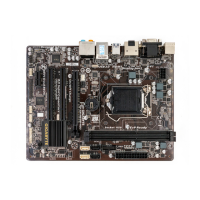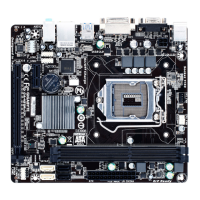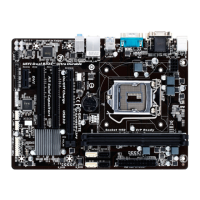Do you have a question about the Gigabyte GA-H81M-DS2V and is the answer not in the manual?
Details conformity with FCC standards for electronic devices.
Guides users on how to find the motherboard's revision number.
Lists the items included in the motherboard packaging.
Essential safety and handling guidelines before hardware installation.
Details the technical specifications and features of the motherboard.
Step-by-step instructions for installing the central processing unit (CPU).
Guidelines for properly installing RAM modules onto the motherboard.
Instructions for inserting expansion cards like graphics or sound cards.
Identification and description of connectors located on the motherboard's rear panel.
Explains the purpose and location of internal motherboard connectors.
Details the ATX power connectors and their pin assignments for stable power.
Explains the CPU and system fan headers and their pin configurations.
Describes the SATA connectors for storage devices and their pin assignments.
Details the SATA2 connectors and their pin assignments for storage devices.
Guides connection of chassis front panel components like power/reset buttons and LEDs.
Explains the front panel audio header for connecting microphone and speakers.
Details the USB 2.0/1.1 headers for connecting internal USB ports.
Information on the CMOS battery, its function, and replacement.
Instructions on how to use the jumper to reset BIOS settings to default.
Describes the initial GIGABYTE logo screen displayed during system boot.
Details the Motherboard Intelligent Tweaker (M.I.T.) for system performance tuning.
Displays motherboard model, BIOS version, date, and system time settings.
Configures boot options, security settings, and system startup behavior.
Configures onboard devices like graphics, audio, LAN, and USB controllers.
Settings to control system power states and wake-up events.
Options for saving BIOS changes, exiting, or loading default settings.
Instructions for installing essential drivers for the motherboard.
Explains the WEEE symbol and proper disposal of electronic waste.
Provides information on accessing GIGABYTE's global support and service system.
| Non-ECC | Yes |
|---|---|
| Memory voltage | 1.5 V |
| Memory channels | Dual-channel |
| Memory slots type | SO-DIMM |
| Supported memory types | DDR3-SDRAM |
| Maximum internal memory | 16 GB |
| Supported memory clock speeds | 1333, 1600 MHz |
| Processor socket | LGA 1150 (Socket H3) |
| Processor manufacturer | Intel |
| Compatible processor series | Intel Celeron, Intel Pentium |
| Intel® Core i3/i5/i7/i9 series | i3-4xxx, i5-4xxx, i7-4xxx |
| USB 2.0 connectors | 2 |
| Number of SATA connectors | 4 |
| USB 3.2 Gen 1 (3.1 Gen 1) connectors | - |
| eSATA ports quantity | 0 |
| USB 2.0 ports quantity | USB 2.0 ports have a data transmission speed of 480 Mbps, and are backwards compatible with USB 1.1 ports. You can connect all kinds of peripheral devices to them. |
| Ethernet LAN (RJ-45) ports | 1 |
| Component for | PC |
| Power source type | ATX |
| Motherboard chipset | Intel® H81 |
| Audio output channels | 7.1 channels |
| Motherboard form factor | micro ATX |
| Windows operating systems supported | Windows 7 Home Basic, Windows 7 Home Basic x64, Windows 7 Home Premium, Windows 7 Home Premium x64, Windows 7 Professional, Windows 7 Professional x64, Windows 7 Starter, Windows 7 Starter x64, Windows 7 Ultimate, Windows 7 Ultimate x64, Windows 8, Windows 8 Enterprise, Windows 8 Enterprise x64, Windows 8 Pro, Windows 8 Pro x64, Windows 8 x64 |
| Supported storage drive interfaces | SATA |
| Maximum resolution | 1920 x 1200 pixels |
| BIOS type | UEFI AMI |
| ACPI version | 2.0a |
| Depth | 170 mm |
|---|---|
| Width | 244 mm |
